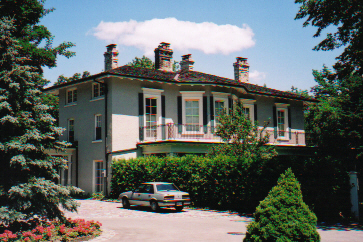

This is probably the oldest Toronto residence still used as a private home. In 1834, Francis Cayley bought the eastern part of George Playter’s farm lot, including the Playter house. He named it for a round hill in the Don Valley that he could see from the house. The hill resembled a sugar loaf, or a drumsnab, in the dialect of England’s north country. In “Toronto of Old” Henry Scadding quoted an 1849 observer: “The most picturesque spot near Toronto and within four miles of it is Drumsnab, the residence of Mr. Cayley. The mansion is roomy and of one storey, with a broad veranda. It is seated among fields and woods, on the edge of a slope; at the bottom winds a river; opposite is a most singular conical hill, like an immense Indian tumulus for the dead; in the distance, through a vista cut judiciously through the forest are seen the dark blue waters of Lake Ontario. The walls of the principal room are covered with scenes from Faust, drawn in fresco, with a bold and masterly hand, by the proprietor.” Drumsnab’s walls were thirty inches thick and covered with stucco. The ceilings were twelve feet high.
Calvley’s younger brother, John, who lived at Drumsnab, c 1850, added a second floor with a ballroom and several bedrooms. During this period, Cayley began selling off his property. John sold Drumsnab and its acreage to Maunsell Jackson. Only eight acres around the house and twenty-six in the valley remained. The rest had become part of the suburb of Rosedale. Maunsell and his sister lived at Drumsnab for eighty-eight and ninety years respectively. When the Prince Edward Viaduct was built across the Don River in 1914, part of the Drumsnab property was expropriated, and more when the ramp to the Don Valley Parkway was built in 1961. Most of the remaining was subdivided in 1965. (For more about Drumsnab and its owners, see “The Estates of Old Toronto” by Liz Lundell and “Rosedale” by Bess Crawford).
